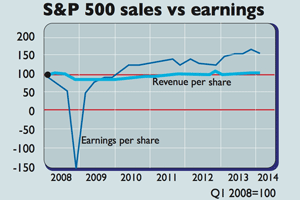Share buyback boom subsides
The bull market in stocks looks set to lose one of its drivers as companies buy back fewer shares.

US company profits beat expectations in the second quarter of 2014. Companies in the S&P 500 index grew earnings per share (EPS) by 8.4% on average the best quarterly showing in three years.
But dig a bit deeper and the profit picture isn't as robust as it looks. And this is true not just of the recent quarter, but of the entire post-crisis profit rebound.
For a start, healthy earnings growth doesn't reflect the underlying economy. Sales (revenue) growth has been very weak, as the chart shows. Instead, the boost to earnings has come partly from historically high profit margins, which in turn have been helped greatly by sluggish wage growth.
MoneyWeek
Subscribe to MoneyWeek today and get your first six magazine issues absolutely FREE

Sign up to Money Morning
Don't miss the latest investment and personal finances news, market analysis, plus money-saving tips with our free twice-daily newsletter
Don't miss the latest investment and personal finances news, market analysis, plus money-saving tips with our free twice-daily newsletter
However, firms have also exploited another way to boost EPS they have been buying back their own shares. Buybacks raise EPS by reducing the number of outstanding shares.
Buybacks can boost share prices, as some investors see them as a sign that a stock is cheap why would management buy the stock otherwise? As Michael Mackenzie notes in the Financial Times, since the start of 2013, a US exchange-traded fund (ETF) that tracks firms doing buybacks has beaten the S&P by a third.
But "a less charitable view" is that management is out of ideas for investing to grow the business. There's also the fact that buybacks can boost managers' bonus payments by giving EPS a key performance measure an artificial lift.

The first quarter of 2014 marked the peak of the buyback wave, with $160bn announced, compared to $120bn in the second quarter.
Why is the momentum ebbing? Many companies have taken advantage of record-low interest rates, fuelled by quantitative easing (QE), to borrow money to fund buybacks. But QE ends in October, while net debt in the American corporate sector now stands at a record $2.3trn, up 14% in the past year.
So, there seems little scope for the buyback boom to keep going. "When it finally sputters, be prepared for it to weigh on forward earnings expectations," says Chris Versace on Foxbusiness.com. The bull market, in short, looks set to lose one of its drivers.
Get the latest financial news, insights and expert analysis from our award-winning MoneyWeek team, to help you understand what really matters when it comes to your finances.

-
 Metals and AI power emerging markets
Metals and AI power emerging marketsThis year’s big emerging market winners have tended to offer exposure to one of 2025’s two winning trends – AI-focused tech and the global metals rally
-
 8 of the best houses for sale with beautiful fireplaces
8 of the best houses for sale with beautiful fireplacesThe best houses for sale with beautiful fireplaces – from a 15th-century cottage in Kent to a 17th-century palazzo in Oxfordshire